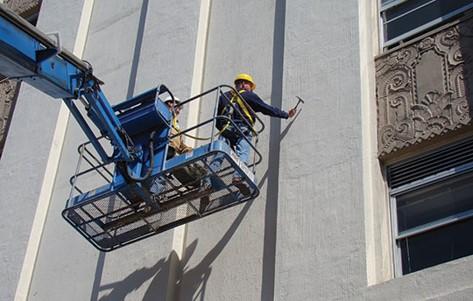Case 2
- Introduction
- Causes of Defects
- Good Practices
- Standards
- Maintenance and Diagnostics
- Remedial
- Similar Cases
- References
Maintenance and Diagnostics
Maintenance
For decisions on surface repairs, consider the ease of access for future work, relative cost of hiring and erecting scaffolding, and the probable frequency of maintenance in accordance with BS 8221-2, SS 509-2 or equivalent. Record and retain documentation of all executed works on façades, including photographs and non-destructive survey techniques, to provide background information prior to further assessment or work. Carry out semi-annual inspections of stone-wall elements and inspect all elevations. Keep accurate and cumulative records of inspection findings in accordance with ASTM C1496, BS 8298-1 or equivalent.
Regular cleaning is critical for the long-term durability and appearance. Perform periodic joint repairs (i.e., sealant replacement, tuck pointing, and cleaning) in accordance with ASTM C1496, BS 8298-1 or equivalent. Perform repairs and restoration works in accordance with ASTM C1722-18, BS 8221-2 or
equivalent. For cases of cracked or broken surface, carry out the following: a) Seek assistance for surface replacement; b) Tuck point or caulk crack with sealant if fragments are stable and secure; c) Monitor closely for additional cracking or movement.
Diagnostics of Defect (see also NDT)
Hammer Tapping Test
Tapping test may be used to detect hollowness, delamination, spalled or debonded plaster.by listening to the ‘void’ sound.

Visual inspection
- Check the nature of rendering, its strength and adherence to the brickwork.
- Check the type of bricks. Examine the layers of rendering immediately in contact with the brickwork and also the surface of the bricks for signs of whitish crystals or whitish deposits. In cases of doubt analyses should be made of any deposits, of the rendering and the bricks.
- The composition of the rendering should be checked from specification.
- A comparison should be made of the position of the cracks in the rendering with any cracks in the walls.
Thermography can be used to identify the position of cracks. A range of crack widths, representing mechanical damage, has been induced under controlled laboratory conditions. The method is based on the characteristics of heat flow phenomenon, in a conductive medium of specific geometry, which is intended to model predetermined boundary conditions.


The tiles’ key, the substrate’s condition and extent of preparation, evidence of external staining, evidence of real movement joints, the adhesive type and original specification and evidence of structural movement.
Sound tests were conducted on the defective areas. It involves knocking on the tile surface with a metallic tool. A hollow sound is usually an indication of poor bonding.
Pull-off Test can be carried out to determine the adhesive strength of the tiles with its substrate.

